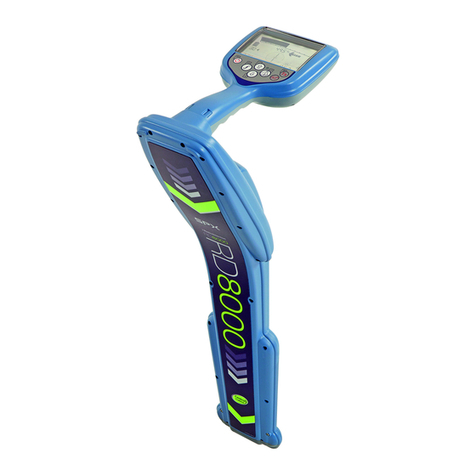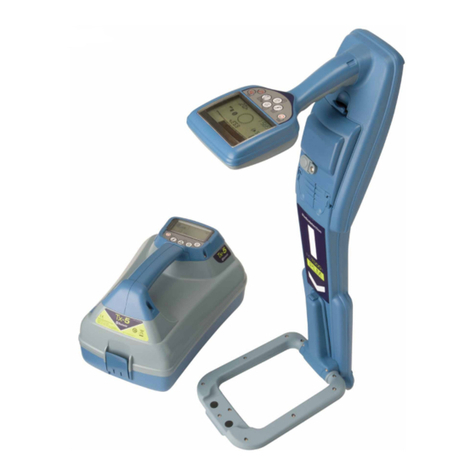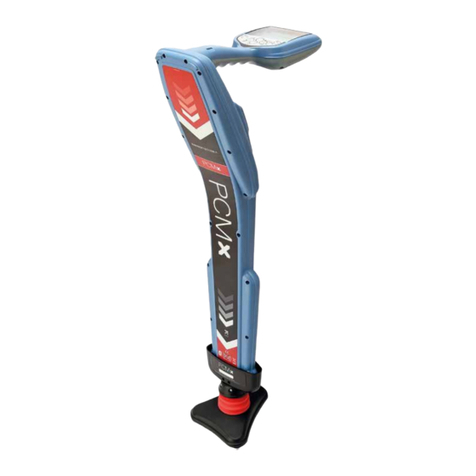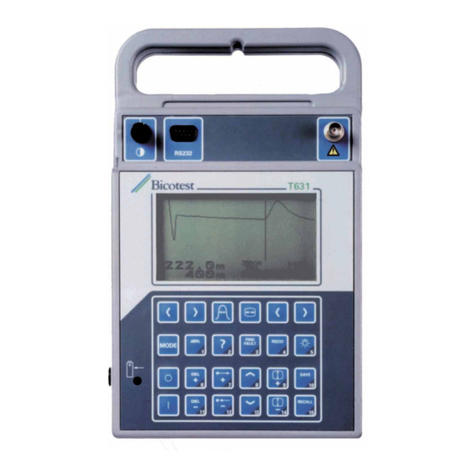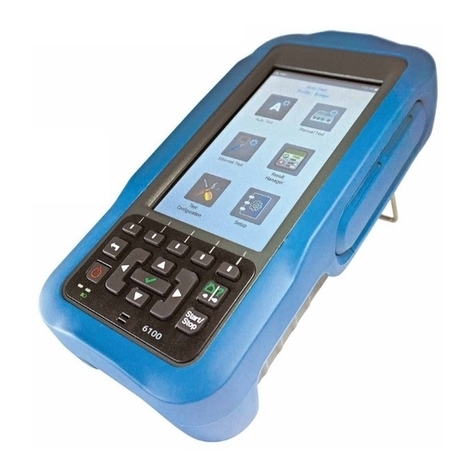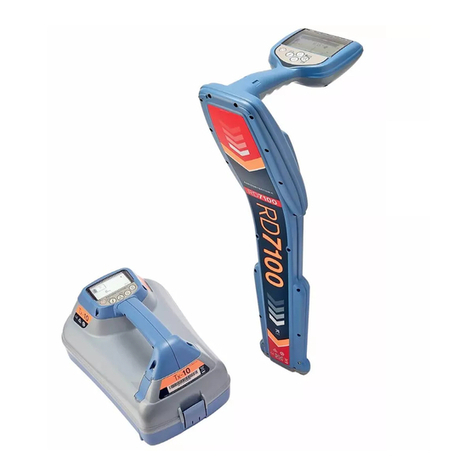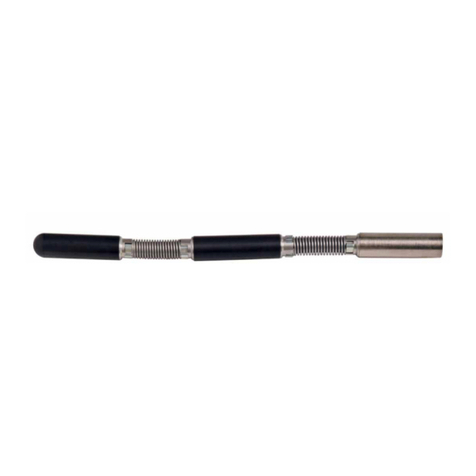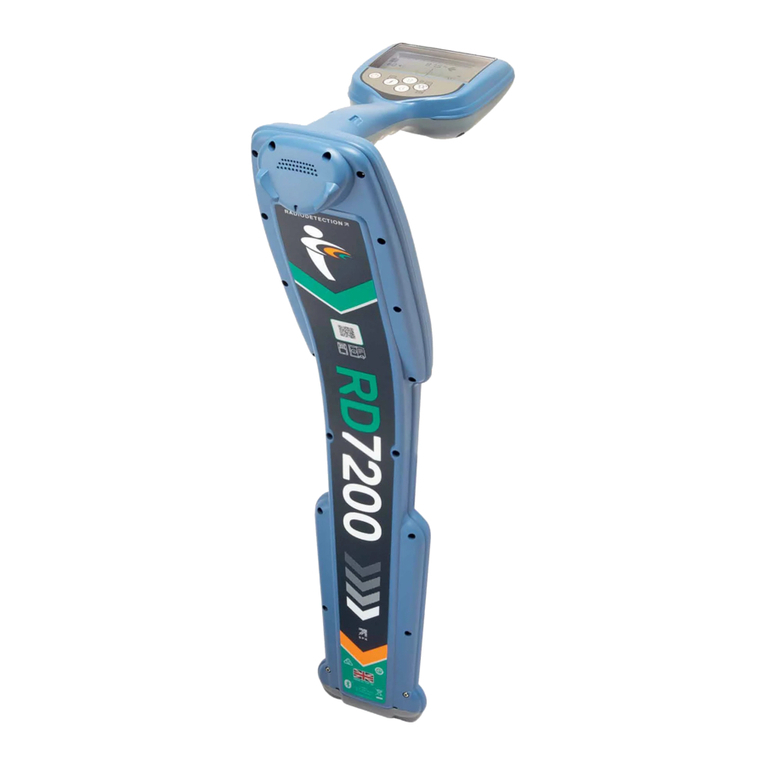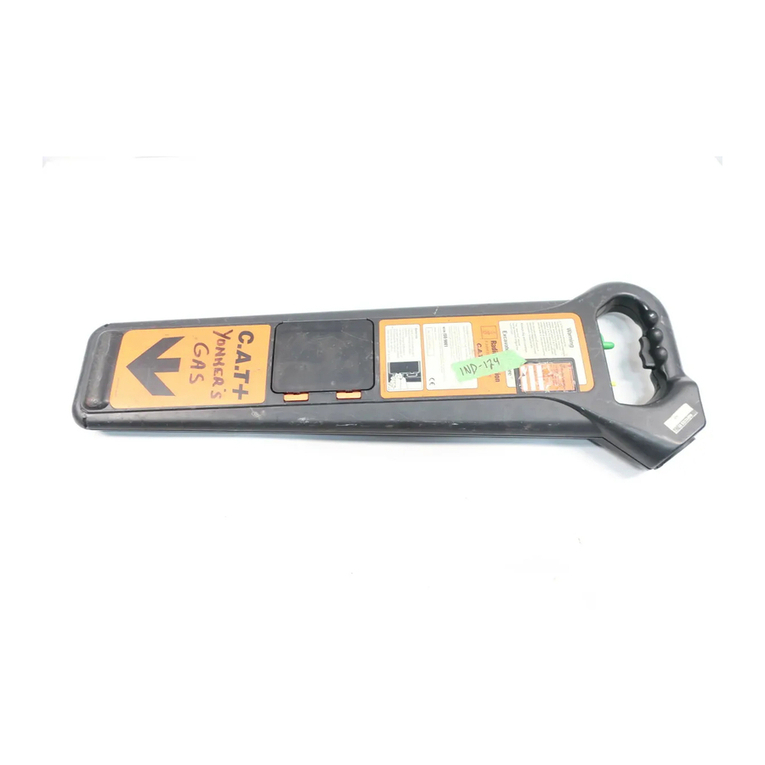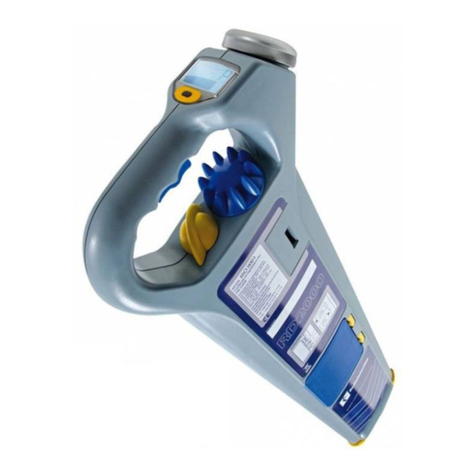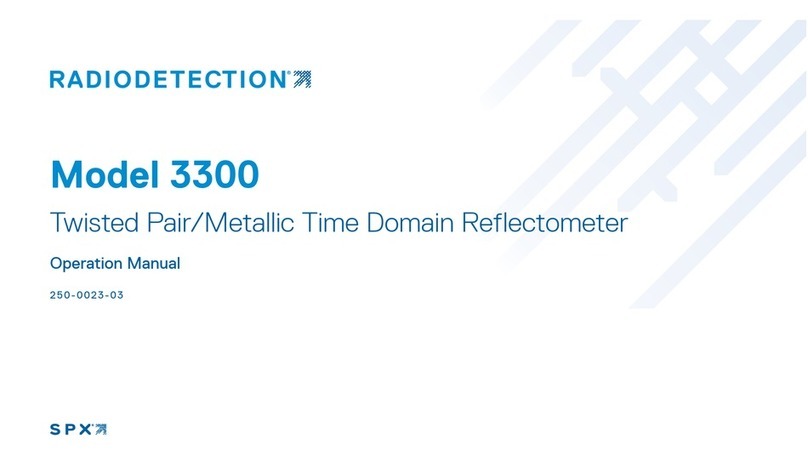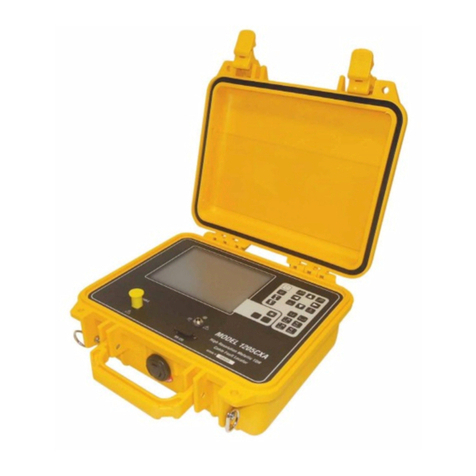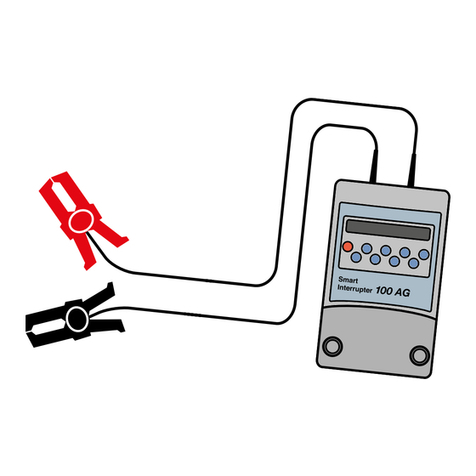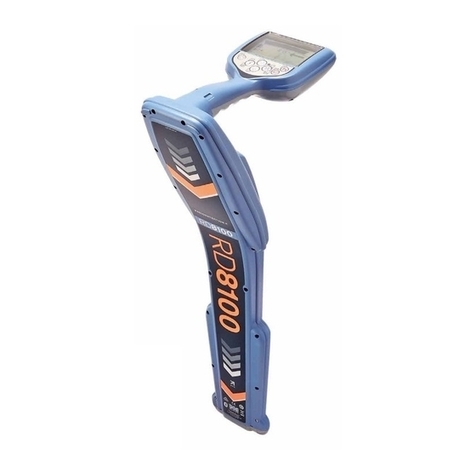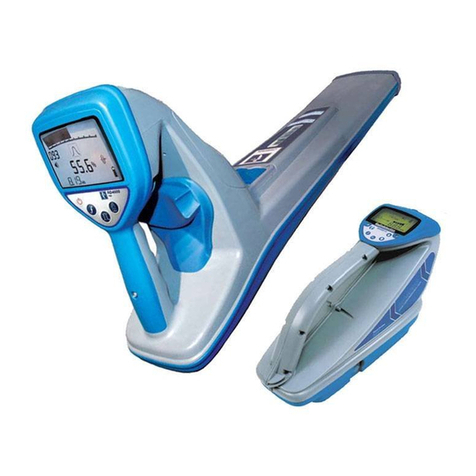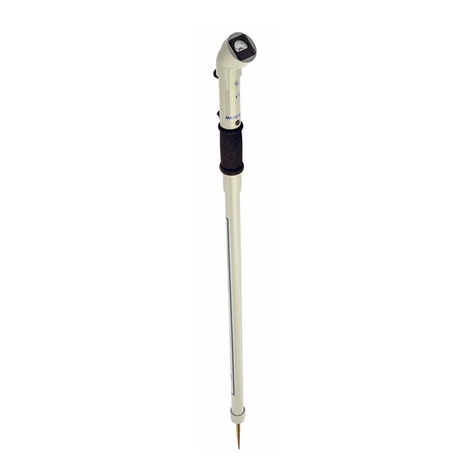Using Radio mode
Set the Function Switch to Radio.
Follow the same procedure as outlined in‘Using the
Power mode’.
WARNING
Increased risk of property damage, death, or serious injury
may result if buried utilities, pipes, and cables are not
properly located before digging.
Make sure to read and follow all instructions and warnings in
the owner's guide when using the C.A.T3and Genny3.
The C.A.T3detects most buried cables and conductors, BUT
SOME CABLES AND CONDUCTORS (EVEN LIVE ONES) DO
NOT RADIATE SIGNALS, SO THE C.A.T3WILL NOT DETECT
THEM. Also, the C.A.T3does not indicate whether a signal
comes from a single cable or conductor or from several
cables or conductors buried in close proximity to each other.
When using the C.A.T3, check whether the StrikeAlert™
feature is activated by looking for the ‘StrikeAlert™Activated’
labels situated either side of the display.
The StrikeAlert™feature is activated by cables or conductors
radiating a power or Genny signal that the C.A.T3can detect,
BUT NOT ALL LIVE CABLES AND CONDUCTORS RADIATE
A SIGNAL THAT THE C.A.T3CAN DETECT. THEREFORE,
NON-ACTIVATION OF THE StrikeAlert™FEATURE DOES NOT
GUARANTEE THAT THE AREA IS CLEAR OF SHALLOW OR
LIVE CABLES OR CONDUCTORS.
Even if using a C.A.T3and Genny3, ALWAYS DIG
WITH CAUTION.
Call your local support number (available from www.
radiodetection.com) for questions regarding the proper use,
maintenance, and repair of the C.A.T3and Genny3.
Locating with the C.A.T3and Genny3
The Genny3is used to apply a tone to a buried conductor.
This signal can be traced using the C.A.T3locator switched
to the Genny mode.
Direct Connection
Direct connection is an
efficient form of signal
application and is
suitable for connection
to a valve, meter, junction
box or other access point.
WARNING
Connection to a power cable sheath should only be
undertaken by qualified personnel.
Method
Unscrew the housing and insert the single LR6 or AA type
alkaline battery in the orientation shown by the diagram
in the battery compartment.
Note
Placing the battery in the incorrect orientation will not harm
the Mouse and is a good method of storing the battery
when not in use.
Place the Mouse on
the ground, set the
C.A.T3to Genny
mode and, whilst
holding the C.A.T3
in line with the
Mouse, check that
the signal is being
received.
Insert the Mouse
approximately 1m/yd
into the duct or drain
and adjust the C.A.T3
sensitivity to receive
the signal.
Smaller ghost signals appear before and behind the main
signal position. Locate all three peaks to be sure the largest
middle one is identified as the Mouse position.
Rotating the C.A.T3about it’s axis to obtain the largest signal
puts the blade of the C.A.T3in line with the Mouse and is a
good way of identifying the direction of the duct or pipe.
Method
Decide if the Genny3is to be switched to pulse or continuous
operation. As a guide, depth measurements are best done
with a continuous signal. If battery power saving is an issue,
switch to pulse operation. A pulsing signal may also be easier
to detect as the signal gets weak towards the end of the
trace length. The pulse/continuous switch is located on the
underside of the Genny3.
Plug the connection lead into the Genny3connection socket
and attach the red lead to the target line. If necessary, clean
the connection point to ensure a good electrical contact.
If the jaws of the clip do not open far enough, and the
connection point is a ferrous material, use the magnet
that is on the clip to attach it.
Clip the ground lead to the earth stake which should be
placed in the ground 3 or 4 paces away from, and at right
angles to the target line.
Alternatively the ground lead may be clipped to the rim of
a valve box or manhole cover. Use the earth spool lead to
extend the earth connection if necessary.
Switch the Genny3on. After an initial warble, a good
connection is indicated by a drop in loudspeaker tone. If there
is no tone or it is a very slow bleep, replace the batteries.
Switch the C.A.T3to Genny mode (or AvoidanceScan™if
conducting a general sweep) and begin to trace the line from
the point of application. Keep the blade of the C.A.T3vertical
and across the probable direction of the line. Move slowly
backwards and forwards over the conductor, reducing the
sensitivity for a narrower response. If using the C.A.T3V or
C.A.T3+, use the meter deflection to aid pinpointing.
Maximum audio and meter deflection will indicate the
position of the target line.
When directly over the line and with the sensitivity level set
for approximately 3⁄4 deflection, rotate the C.A.T3on it’s axis
until a signal minimum is found. The blade is now in line with
the target line. Continue tracing the line as outlined above.
Induction
Induction is a convenient and quick way of applying the
Genny3signal to a pipe or cable where limited access does
not permit direct connection or the use of a signal clamp.
Set the Genny3to pulse
or continuous mode.
Place the Genny3over
the assumed position
of the conductor and
in the orientation shown.
Method
Plug the Clamp into the Genny3Connection socket.
Place the Clamp around the pipe or cable ensuring the
jaws are closed. Switch the Genny3on. Open and close
the Clamp. If the jaws are closing correctly there will be
a change in tone as the jaws are closed.
An earth connection, from the Genny3, is not necessary
but efficient signal transfer is only achieved if the target
line is grounded at both ends. This is usually the case
with power cables.
The Signal clamp can be used with the Genny3set
to either pulse or continuous mode.
Using the optional Live Plug Connector
The Live Plug Connector applies the Genny signal to a live
domestic power socket and, via the domestic wiring system,
to the service and supply cable in the street.
Method
Connect the Live Cable Connector to the Genny3socket
and the mains power socket.
Switch the Genny3and power socket on.
Note
The Live Plug Connector provides protection to 250Vac.
Using the optional Mouse Signal Transmitter
The Mouse is a small self-contained watertight transmitter
which can be detected by the C.A.T3when switched to the
Genny mode.
76 8 9 10 11
Start tracing the target line at least five paces from the Genny3
with the C.A.T3set in the Genny mode. Working too close to
the Genny3may give false readings as the C.A.T3will detect
radiated signals directly from the Genny3rather than the
target line.
Active search using Induction
Placing the Genny3on it’s side swamps an area with Genny
signal. Note that signal is not transmitted directly below the
Genny3in this orientation, so repeat the exercise with the
Genny3moved to the side by at least one metre.
Alternatively, use a two man
technique to search
an area for buried
utilities as shown.
Using the optional Signal Clamp
The Signal Clamp applies a Genny signal safely to a pipe
or live cable up to 76mm (3 inches) diameter, without
interrupting the supply.
Taking line depth measurements using
the C.A.T3+ and Genny3
For best accuracy use the Genny3in continuous mode (it is
possible to perform depth measurements with the Genny3
set to pulse mode but a slight reduction in accuracy may be
experienced).
Method
Locate the target line as described previously.
If using the Genny3in induction
ensure that the depth measurement
position is at least 30 paces
from the Genny. If using direct
connection or a signal clamp,
this distance can be reduce to
approximately 5 paces.
Hold the C.A.T3still, vertical and at right angles to the buried
line. Momentarily depress the depth button. The display will
show a moving clockface followed by the depth measurement.
Taking Mouse depth measurements using the C.A.T3+
Depth measurements are only possible when using the C.A.T3+
in the Genny mode with a Mouse+ transmitter, identified with a
central orange band.
Method
Locate the main Mouse signal as previously described. Hold
the C.A.T3vertical and in line with the Mouse. Press and
hold the depth button until ‘M’ appears on the display and
then release. A clockface will appear in the top right hand
corner of the display while the depth calculation is made. The
approximate depth to the Mouse will then be displayed.
Note
If the StrikeAlert™ feature is enabled the alarm will activate
at approximately 1.2m when locating a sonde. If this is an
inconvenience, the StrikeAlert™feature can be disabled in the
Genny mode by pressing and holding the depth button for the
duration of the battery test bleep at switch on.
C.A.T3+/C.A.T3V error codes
Error messages
Flashing indicates conductor out of range.
indicates depth attempted in radio which is not allowed.
not possible to indicate depth eg, high interference.
WARNING
Do not use the C.A.T3+ depth measurement to decide if
mechanical digging over a buried conductor is appropriate.
